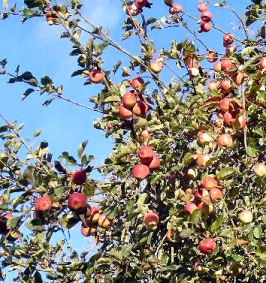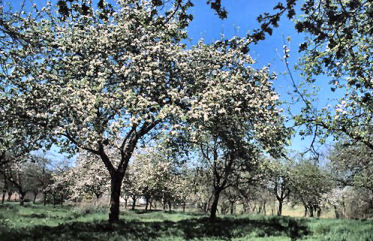

|
It is now known that the Malus silvestris (apple tree) grew wild in Britain around 4000BC, and archaeologists working on the Windmill Hill site in Wiltshire, have discovered evidence which indicates that its fruit were eaten as food, but these would have been wild fruits, as no archaeological evidence to support any deliberate attempt to cultivate the trees this early has so far been discovered. In fact the first evidence found for deliberate cultivation dates from the period of the Roman invasion of Britain in AD43, when, after army veterans were offered settlements of land on which to grow fruits, probably as an inducement to stay, orchards spread across the country. In Europe, cider making was already well established by the beginning of the 9th century, and the Normans, who invaded England in 1066, had a strong tradition of apple growing and cider making. After the Conquest they would have been responsible for a marked change in the practice of apple growing in England, introducing a number of new varieties of apple, the first recorded of which were the Pearmain, which was particularly valued for cider making, and the Costard, which although now no longer grown, is preserved in the word costermonger, who was originally a seller of Costard apples. By the early 13th Century, the production of cider in England had grown to become an important industry, with records confirming many Monasteries of that period regularly sold cider to the public. They also show that labourers in some monastic orchards in medieval England received a daily allowance of cider as part of their wages. Cider has long been regarded as the traditional drink of Devon, and records confirm it has been made here since has at least the 13th Century. In the year 1285-6 the bailiff's account for the Exminster manor of the Earl of Devon shows cider making of sufficient scale as to generate a regular source of revenue. The Black Death, and the Wars of the Roses in the late Middle Ages, resulted in a sharp decline in fruit cultivation in England, but in 1553, this trend was reversed when Henry VIII instigated a vigorous program to reverse this decline, importing large quantities of apple trees from France, and throughout the 16th and 17th centuries, large numbers of new orchards were planted, with the bulk of these being used for cider making. John Hooker, the Exeter historian, writing around 1600, refers to the abundance of fruit in Devon and the careful management of orchards and apple gardens. Greater care was also taken in the 17th Century; both with regard to the varieties of apple planted, and to the quality of the cider made, which clearly did not match the quality of the product made in Normandy where they used specially selected fruits. The Foxwhelp, which appeared in the mid 17th Century, soon became popular and was used in the finest ciders. In Devon to the production of cider seems to have been further increased at this time if the statement of Westcote in his View of Devonshire, written in 1630, can be relied on. He relates that "of late years there had been an enlargement of Devon orchards", particularly for the making of cider which he goes on to describe as being "a drink both pleasant and healthy, much desired of seamen for long southern voyages as more fit to make beverage than beer, and much cheaper and easier to be had than wine." Not all agreed on the quality of the cider produced around this period, the author D Marshall, in his book, "The Rural Economy of Gloucestershire" published in 1796, laments the poor quality of much of the cider then produced, saying "A palate accustomed to sweet cider would judge the rough cider of the farm houses to be a mixture of vinegar and water, with a portion of dissolved alum to give it a roughness." This may in some part be partly due to a decline in the quality of the fruit crop because of canker and also because of poor orchard management. In Devon by the year 1820, as well as the large quantity made for home consumption, eleven thousand two hundred and sixty-five Devonshire hogsheads (each of sixty-three gallons) of Cider were sent from the ports of Exeter and Dartmouth, besides that which was shipped by the growers, and therefore not liable to duty.
The Witheridge Tithe of 1837 shows that there were 109 acres of Orchards in the Parish, and by 1877, Devon had some 23,000 acres of apple orchards spread to almost every part of the county, with most, if not all farms, having at least one orchard. This made Devon the leading county of the time with 22,000 acres in Herefordshire, 21,000 acres in Somerset, then Worcestershire, Gloucestershire, and Kent, each with less than 90000 acres. It was a common practice on farms in the West Country for workers to receive a daily allocation of cider as part of their wages. Varieties of apple developed and used in Devon during the 18th and 19th centuries included Royal Wilding, Meadgate, White-Sour, the Irish Cockagee, Elliot, Sweet Alford and Woodbine. The protection of the fruit market during the Napoleonic Wars, and the high tariffs imposed on all imported fruit after the wars, led to an expansion of new orchard planting in the 1820s and 1830s, but the subsequent lowering of these tariffs in 1837 led to a collapse in the apple market. There was little improvement in the market demand until around 1870, when effects of the industrial revolution in this country led to increased per capita income, and fruits once again became profitable. The customary method of collecting the apple crop was to beat the trees with long slender poles or rods, and then to collect the fallen fruit in baskets. Marshall in his book, 'The Rural Economy of Gloucestershire' published in 1796 condemed this method of harvesting by saying:" The criterion of a due degree of ripeness is that of the fruit's falling spontaneously from the tree. Nature is the best judge of this crisis. No art has yet been discovered, to mature unripe fruit, in any way equal to nature's process. Fruit, in all human probability, does not quit the tree (in an undisturbed state) until it has received its full complement of nourishment." Cider and apples were widely regarded as having health giving properties, with one herbal mention of: "There is an ointment made with the pulp of apples and swine's grease and rose water, which is used to beautify the face, and to take away the roughness of the skin, called in shops pomatum of the apples whereof it is made". The ointment was used to soften the skin and fade freckles. Cider drinking was widely supposed to promote longevity. John Huxham in 1738, made reference to the high regard in which cider was held, by reference to its antiscorbutic properties. It helped to prevent scury on board ship long before the introduction of lemon and lime juice in the eighteenth century. Indeed Huxham attributed the general improvement in the health of many parts of Devon largely to the more extensive use of cider.Apple Tree Wassailing Other traditions are associated with cider, most notably the Wassail. Farmers and farm workers used to salute the apple trees in a ceremony known as wassailing. The time of the wassail varied from Christmas Eve to Twelfth Night. Participants carried jugs of cider into the orchards, drank a health to the trees and the anticipated next year's crop, and poured cider around the tree roots. During the wassailing a great deal of noise was created by banging pots and pans. Wheat flour cakes were eaten at these ceremonies and small pieces of the cake were dipped in cider and placed in the forks of the trees as a thanksgiving to the spirit of the tree. The word Wassail is derived from the Saxon greeting 'Waes Hal', meaning literally, 'good health'. Each year in January the people of the traditional cider making areas of England, Devon, Somerset, Worcestershire, Sussex and Kent wassail their apple trees to ensure a fine crop of cider apples in the summer ahead. Traditionally, to ensure a good apple crop, wassails are held in cider orchards. A local ceremony is held on "twelfth night" - January 6th (Epiphany, also known as old Christmas Day). The earliest written record of wassailing, or 'howling' as it was sometimes referred to in Sussex was at Horsted Keynes in 1670, where the rector recorded giving the 'howling boys' 6d on 26th December. Apple tree wassailing is a ceremony which involves drinking to the health of the apple trees. The Anglo-Saxons used the phrase 'Wæs Hal' as an everyday greeting which literally meant "Be healthy". Since the Anglo-Saxons and Norse shared a custom of welcoming guests by presenting them with a horn of ale, the greeting evolved into a toast. The phrase was eventually contracted into one word, wassail, and came to refer to the act of toasting to someone's health, wassailing, and to a type of alcoholic beverage (spiced ale or punch) used to toast people's health on special occasions. In the Southern England, a set of customs was grouped under the name of wassailing, and they all constituted different forms of wishing health to crops and animals, in much the same way as people passing the wassail bowl wished it to each other. They are mostly well recorded, and they may well have descended from pagan practices. The most widespread and enduring concerned fruit trees, and is first recorded in 1585 in Kent where groups of young men who went between orchards performing the rite for a reward. In the 1630's, Robert Herrick, almost certainly writing about Devon, spoke of 'wassailing' the fruit bearing trees in order to ensure a good yield. Another author of the time, in recording West Country customs said that on 'Twelfth Eve' men 'go with their wassel-bowl into the orchard and go about the trees to bless them, and put a piece of toast upon the roots, in order to do it.' It was traditionally the custom for local local farm workers to visit the orchard after dark with shotguns, horns, food and a container of cider, and select the best tree in the orchard. Cider would then be poured on the roots, and pieces of toast, or cakes soaked in cider would be placed in the forks of branches, or impaled on twigs. Another version in Devon involved hoisting a young boy, representing the spirit of the tree, into the branches where he would be given gifts of bread, cheese and cider. The wassail song would then be sung or chanted to ensure the fruitfulness of the crop for the coming year. Sometimes the tree would be given a clue to what was expected of it, with men circling the trunk bowed down as if under a heavy weight of harvested apples. All would drink from the wassail bowl and the tree would be toasted loudly and merrily. Eventually shotguns were fired, horns blown and a great deal of noise would be made to scare off malevolent spirits and awaken the tree from its winter slumber. Previous Last Edited 03/07/2006 Copyright © 2000-2006 Witheridge Unless otherwise indicated on the page in question, the photographic images reproduced on this site belong to the Witheridge Archives, and, as such may not be reproduced for commercial purposes without written permission. However, you are welcome to use any of the photographs belonging to the archive for personal and/or non-commercial use. Any material shown as not being owned by the archive may not be reproduced in any form without first receiving written permission from the owner of the material in question. A Topographical Dictionary of England, Samuel Lewis, 1831: |



